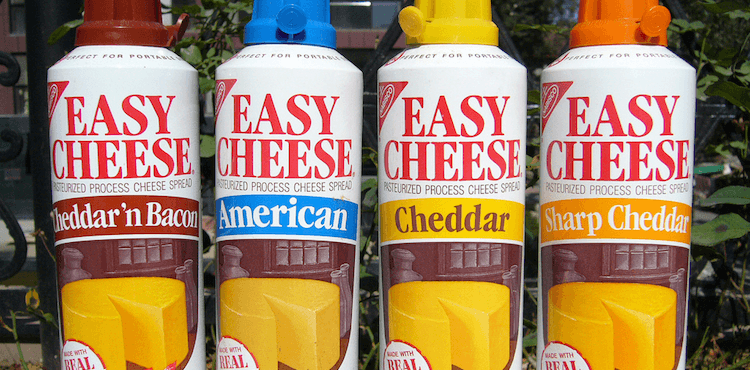
Hold on to your blue boxes and your viscous yellow liquids! This blog series will take you on a wild ride through the history, politics, science, and culture of processed cheese, including the origins of factory cheese, the rise of James L. Kraft, and the miracle of milk protein concentrate.
I love good, organic, artisanal food as much as the next guy. Hell, probably a whole lot more—I really get behind the narrative of Farmer Joe massaging his cows in candlelight before hand-churning a butter so delicious that little dairy angels pop up out of nowhere and give me the thumbs up as soon as I put it in my mouth. Yet what bugs me about a lot of people who subscribe to the idea that wholesome foods are a good and tasty thing is their categorical refusal to eat anything they consider fake, or gross, or processed.
Granted, these food discriminators have some valid points. I understand that passing on that hotdog that’s been rolling on its hotdog treadmill for a couple of hours is probably a good idea. I compute how oozing, gelatinous nacho cheese that’s surely made from some kind of weird corn extract might seem unappealing. I can see how these snacks and treats might stretch the definition of “food.”
Nevertheless, these natural food hawks are missing the one, really great thing about “fake” food: it tastes delicious. Especially “fake,” process cheese.
I do not hesitate to dunk most anything into the extremely yellow substance marketers have dubbed, “Nacho Cheese.” I dump mountains of “Parmesan Style Grated Topping” onto my pizza and pasta. Leave me alone with a jar of jalapeño queso dip and a bag of tortilla chips, and you will never see those food items again. And don’t get me started on the king of the processed cheese world (the most delightful appetizer, entrée, dessert, and all-around hangover-cure champ): Kraft Macaroni and Cheese!
The problem, of course, is that I have no idea what these products are made of. Their branding is comfortable and familiar; their ubiquity in grocery stores and supermarkets across the country ensure they’re never out of consuming reach; their low, low prices never bankrupt my food funds. But their ingredients? I assume they use some kind of cheese, molded and crafted with the genius of twenty-first century food engineering, and I leave it at that.
Well, enough is enough. We have access to a vast body of human knowledge through the power of the Internet, and there is nothing stopping us from tackling those byzantine ingredient labels and deciphering the indecipherable head-on.
So welcome, esteemed reader, to real cheese product, a blog series devoted to taking apart the history, politics, science, and culture of processed cheese. Before getting to the bottom of how these foods-that-are-called-cheese are made, we need to answer an important question: What, exactly, is a cheese product? Fortunately, the U.S. regulatory system has our backs.
In the United States there are three primary categories and one catch-all category for processed cheese: 1) Pasteurized Process Cheese, 2) Pasteurized Process Cheese Food, 3) Process Cheese Spread, and—the catch-all—4) Pasteurized Process Cheese Product.
While these classifications all pretty much sound the same, if you dig deep into the regulations behind them you’ll find distinct differences in specific criteria. Instead of general “cheesiness” benchmarks, these categories measure the fat content, moisture content, and optional (literally “optional”) ingredients. Here’s the breakdown:
- Pasteurized Process Cheese
- This process cheese isn’t too, too different from the real deal. For a food to reside comfortably in this category, it needs to maintain the same fat content as “the corresponding natural cheese” and a maximum moisture content that cannot be more than 1% greater than the corresponding cheese. Usually this translates to 43% moisture content and 47% fat content.
- Pasteurized Process Cheese Food
- Moving down the chain, we get a little further away from Farmer Joe—these suckers are allowed more moisture (44%), less fat (23%), and optional ingredients like water, salt, spices, flavorings, or artificial colors.
- Process Cheese Spread
- Because the moisture content of Process Cheese Foods offers a fairly solid end result, this classification was created to encompass those good ol’ viscous spreads (think Cheese Whiz). It permits 44–66% moisture content but no more than 20% fat content. Sweeteners, starches, and gums may also be thrown into the melting pot at this stage.
- Pasteurized Process Cheese Product
- My personal favorite category, this is where the FDA tosses any cheese-esque-food that does not meet the three official designations. Cheese Products are left completely undefined. Moisture content can be anything, fat content can be anything, and a wide variety of optional ingredients can jazz these products up.
So there you have it, gang. May the More You Know rainbow shine down upon you as you peruse foods, spreads, and products at your friendly neighborhood grocer. Tune in for our next installment on the origins of American factory cheese and the greatest cheese scandal of the nineteenth century!
Photo by Compfight



